Fix: ‘These Files Have Properties That Can’t Be Read” Error on Windows
Some Windows users are reporting that they always end up seeing the ‘These files have properties that can’t be read’ error when attempting to add an Mp4 video to the built-in video editor. This problem is confirmed to occur on Windows 10 and Windows 11.
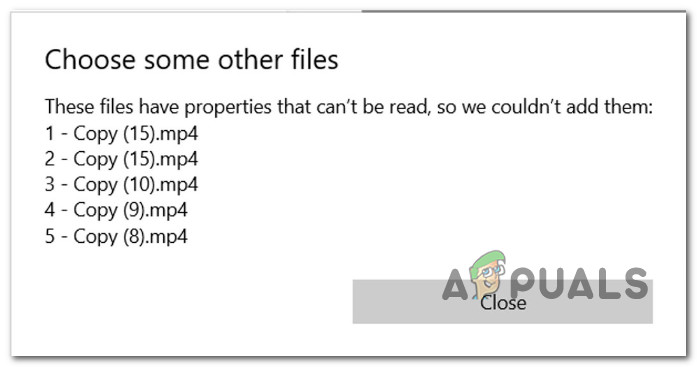
After investigating this particular issue, it became evident that this issue has several potential culprits that might directly or indirectly cause this issue. Here’s a list of scenarios that you should investigate:
- Corrupted Photos app – One of the most frequent reasons why you can expect to deal with this issue on Windows 10 or Windows 11 is when the main Photos app installation is corrupted or contains remnant temporary files. In this case, you should be able to fix the issue by repairing or resetting the Photos app.
- Corrupted cache project – Another scenario that might be responsible for this problem is a corrupted cache project. This typically occurs if there’s an error or an unexpected interruption that affects the project that is currently loaded inside the Video Editor. Most of the time, you can fix this issue by removing the project from the queue and adding it again.
- Corrupted MP4 file – Once you make sure that the issue is not related to a cache or corruption issue, the next thing you should do is make sure that the MP4 file you are trying to add is not affected by corruption. To avoid this issue, there are tools that will allow you to check the integrity of video files and fix them.
- De-registered Photos app – If you started to experience this problem after you installed a Windows Update or after installing a new driver signature, an unintended consequence that might cause this problem is a de-registered Photos app. You can fix this problem by forcing the app to re-register from an elevated Powershell prompt.
- Recent system change – According to several affected users, this type of issue can also occur as a result of a recent system change that ended up making some permission changes that ended up affecting the Photos component. In this case, you can fix the issue by using System Restore to revert your PC back to a state in which this issue was not occurring.
- System File corruption – Under certain circumstances, you can end up dealing with this issue if your system is plagued by some type of system file corruption that affects the Photos component and sub-components. In this case, the best way of resolving the issue is to perform a repair install or clean install.
Now that we went over every potential reason why you can expect to deal with the ‘These files have properties that can’t be read’ error, let’s go over a series of verified fixes that other affected users have successfully used to get to the bottom of this issue.
1. Repair the Photos app
If you’re just starting to troubleshoot the issue, the first thing you should do is attempt to repair the Photos app from the Installed Apps section inside the Settings menu.
Several affected users have confirmed that once they did this, they finally managed to import MP4 files inside the Video editor without getting the ‘These files have properties that can’t be read’ error.
This is an ideal way of repairing the Photos app since this method will effectively scan every sub-component of the Photos app (including the video editor).
Follow the instructions below for complete steps of repairing the Photos app and avoid the ‘These files have properties that can’t be read’ error inside the Video Editor:
- Press Windows key + R to open up a Run dialog box. Next, type ‘ms-settings:’ and press Ctrl + Shift + Enter to open up the Settings menu.

Access the Settings menu on Windows - Once you’re inside the Settings menu, use the side menu on the left to click on Apps.
Note: If the side menu is not visible by default, click on the three-line icon (top-left section of the screen) to bring it forward. - Next, click on Installed apps from the side menu on the right.
- Inside the search function at the top, type ‘photos’ and press Enter to find the Photos app.
- From the list of results, click on the action icon associated with Microsoft Photos.

Access the Advanced Options menu - Next, scroll down to the bottom of the screen and click on the Repair button under Reset.
- Wait until the repair procedure is complete, then restart your PC and wait until the next startup is complete.
- Once your PC boots back up, open the Video Editor once again and see if you can import MP4 files without getting the same ‘These files have properties that can’t be read’ error.
If the issue is still not fixed, move down to the next method below.
2. Remove the currently cached project
As it turns out, this particular issue can also occur in scenarios where the issue is caused by cached data restricted to the Video Editor.
Several users that we’re also dealing with this problem have confirmed that they managed to fix this issue simply by opening the Video Editor and removing the currently cached project.
Note: Depending on whether you can afford to lose your current Video Editor project, decide if this method is applicable to you.
If you want to pursue this method, follow the instructions below:
- Press Windows key + R to open up a Run dialog box. Next, type ‘ms-photos:’ inside the text box, then press Ctrl + Shift + Enter to open up the Photos app.

Access the Photos app - At the User Account Control (UAC), click Yes to grant admin access.
- Once you’re inside the Photos app, click on Video Editor from the horizontal menu at the top.
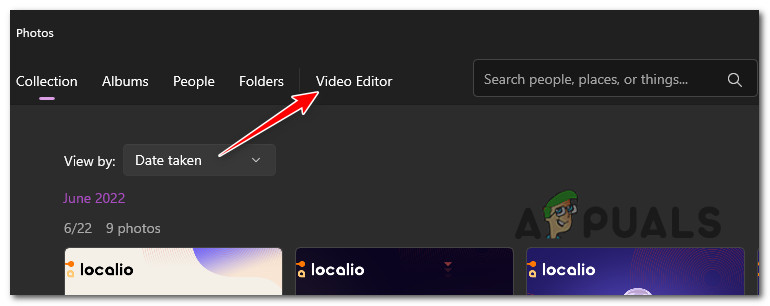
Access the Video Editor component - To delete the currently cached project, click on the check box associated with it, then click on the trash can icon in the top-left corner.
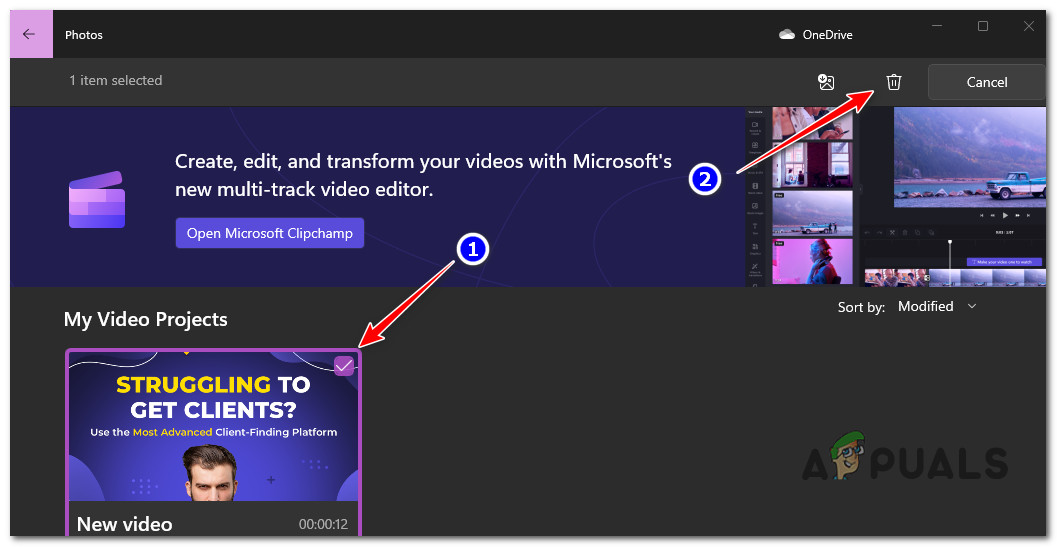
Delete the Project - Once the project has been deleted, close the app and reboot your PC to clear the cache, then launch the Video Editor once again, add a new project and see if the problem is now fixed.
If the problem is still not fixed, move down to the next method below.
3. Reset the Photos app
If the repair procedure above did not work for you, the next thing you should do is reset the entire Photos component. Doing this will also affect the Video Editor which is a sub-component of Microsoft Photos.
Note: Keep in mind that resetting this component will also clear any remnant cached data and personal preferences. This will affect the Photos app and the Video Editor.
If you are aware of the consequences and you want to attempt this reset procedure, follow the instructions below:
- Press Windows key + R to open up a Run dialog box. Next, type ‘ms-settings:’ and press Ctrl + Shift + Enter to open up the Settings menu.

Access the Settings menu on Windows - Once you’re inside the Settings menu, use the side menu on the left to click on Apps.
Note: If the side menu is not visible by default, click on the three-line icon (top-left section of the screen) to bring it forward. - Next, click on Installed apps from the side menu on the right.
- Inside the search function at the top, type ‘photos’ and press Enter to find the Photos app.
- From the list of results, click on the action icon associated with Microsoft Photos.

Access the Advanced Options menu - Once you’re inside the Advanced Options menu, click on the Reset button (under Reset).
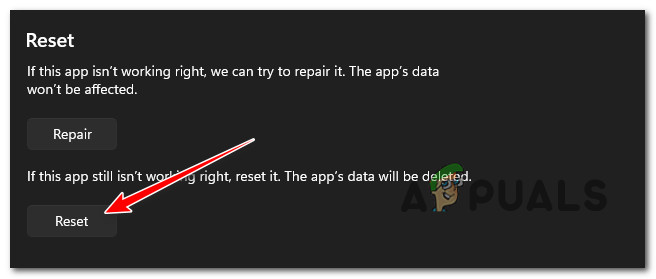
Reset the Microsoft Photos component - Once the operation is complete, reboot your PC and see if the ‘These files have properties that can’t be read’ error is fixed once the next startup is complete.
If the next problem is still occurring, move down to the next method below.
4. Check if the MP4 file is corrupted
If you’ve come this far and none of the proposed solutions worked for you, one other thing you should try is to investigate the integrity of the MP4 file you are attempting to add.
More often than not, this problem is rooted in some kind of corruption affecting the video file.
To tackle this potential problem and figure out if the video file is corrupted or not, you can leverage an online tool like Fix.Video.
All you need to do is drag and drop the problematic MP4 video inside the tool and have it inspected.
If the utility is able to fix the video corruption, upload it again inside the Video Editor and see if the problem is now resolved.
On the other hand, if the video is unrepairable, reboot tries uploading a new variant inside the Video Editor, and see if the issue is fixed.
If the same issue is still occurring, move down to the other fix below to troubleshoot against a potential case of system file corruption.
5. Re-Register the Photos app
A deregistered Photos app may be an unintentional result that contributes to this issue if you first noticed it after installing a Windows Update or a new driver signature. By requiring the app to re-register from an elevated Powershell prompt, you can resolve this issue.
Note: This method will only be effective if the Photos app is actually de-registered. If the Photos app is still registered on your PC, the steps below will not produce any effects on your PC.
Follow the instructions below to re-register the Photos app:
- Press Windows key + R to open up a Run dialog box.
- Next, type ‘powershell’ inside the run dialog box, then press Ctrl + Shift + Enter to open up an elevated Powershell window.

Open an elevated Powershell window - When you’re prompted by the User Account Control (UAC), click Yes to grant admin access.
- Once you’re inside the elevated Powershell window, type or paste the following command and press Enter to re-register the Photos app:
Get-AppxPackage -allusers Microsoft.Windows.Photos | Foreach {Add-AppxPackage -DisableDevelopmentMode -Register "$($_.InstallLocation)\AppXManifest.xml"} - Once the command has been successfully processed, reboot your PC and repeat the action that was previously causing the ‘These files have properties that can’t be read’ error.
If the same kind of problem is still occurring, move down to the next method below.
6. Perform a System Restore
If all else fails, you can attempt to resolve the “These files have properties that can’t be read” error by reverting your PC to a previous system restore point when the Video Editor of the Photos app was operating regularly.
This has helped several users find a solution to the problem.
You can restore your computer to a previous state using Windows’ System Restore feature. This can be applied to resolve issues like broken systems.
To get your computer back in working order, follow these steps:
- To launch the Run command, press the Windows key plus R.
- To launch the System Restore wizard, type “rstrui” in the Run box and press Enter.

Opening the System Restore - Choose a different restoration point on the following screen, then click the Next button.
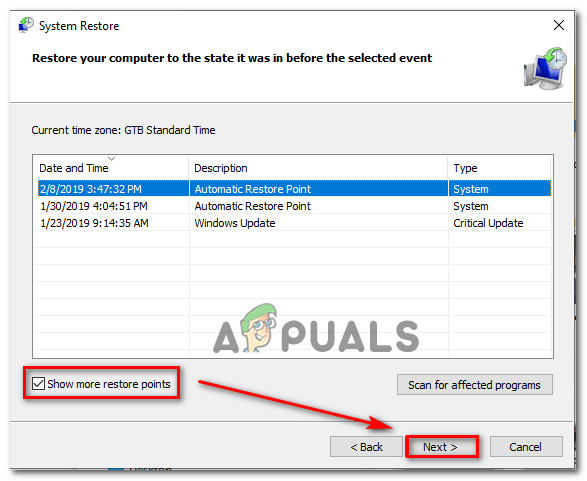
Open a restore point Note: Be sure to choose a restore point that was created before you discovered this mistake, then click Next once more.
- After the restoration process has begun, click Finish and watch as your computer restarts.
- Restart your Windows PC to see if you can get beyond the “These files have properties that can’t be read” error to see if the issue has been resolved.
Continue to the method below in the event that the issue is still not resolved.
7. Perform a clean install or repair install
If none of the aforementioned changes have helped you, you probably have a major system file corruption that can’t be fixed using standard methods. If this situation applies, you should just reset all relevant Windows components that can end up having an impact on the System Restore component.
You can either perform a full OS drive wipe or just target the files related to your operating system to accomplish this:
- Clean Install – Of the two operations, this one is simpler because you may perform it directly from the menus of your Windows version and without the usage of installation discs. This is only advised if you don’t care what happens to the private information you’re currently storing on the drive.
- Repair install – This procedure, often referred to as an in-place repair, is advised if the OS drive (C:) currently houses important data that you can’t afford to lose. However, keep in mind that in order to make this work, you must use suitable installation media. The key benefit of this approach is that all of your personal material, games, apps and user preferences will be preserved.




